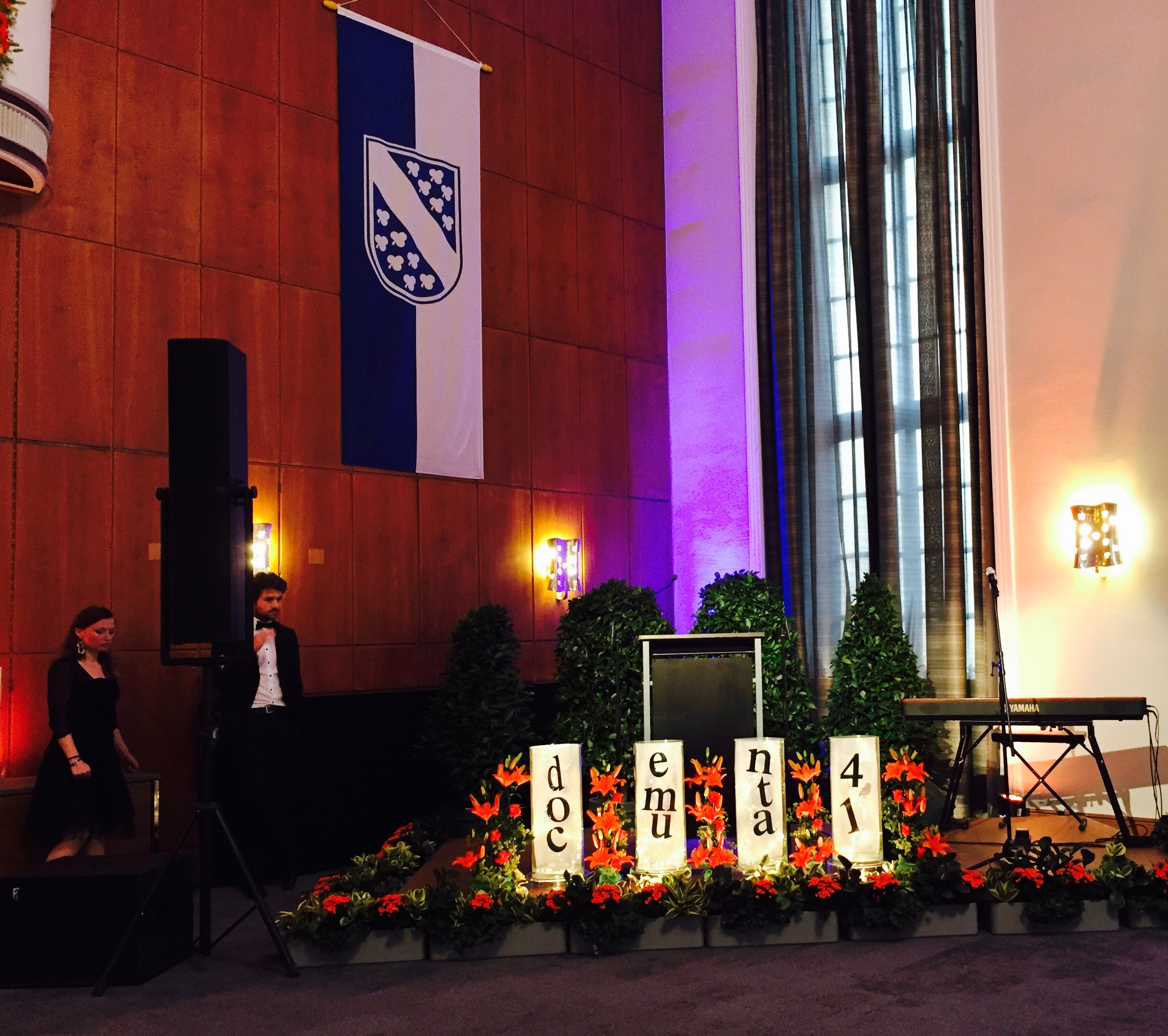
by Jean Marie Carey | 24 Aug 2017 | Art History, LÖL, Re-Enactments© and MashUps

Arin Rungjang, 246247596248914102516 … And then there were none (2017). Video still.
The German friend I went with said aloud what I was thinking: “Whoever at Documenta decided to call this the ‘Neue Neue Galerie’…just…shouldn’t…ever…” accompanied by a grim sächsische head-shake. Restyling the already-interesting and well-known Brutalist Neue Post building in this way is so typical of Documenta 14: It’s that Mentos-commercial “humor” that isn’t funny and also isn’t nostalgic, ironic, kitschy, or whatever else might have settled the account with the “marketing team.” Nonetheless despite being afflicted by branding and the continuing curatorial confusion that has muddled much of Documenta 14, some of the art inside the former mail-sorting center ascends on its own merits.
The most interesting, and centrally important to Kassel, entries in all of Documenta is the project by the Society of Friends of Halit, a group of artists and researchers who apply pressure to the investigation into the 2006 murder of 21-year-old Halit Yozgat. Yozgat was shot to death in the Internet café his family ran on Höllandischestraße, just around the corner from the Neue Post, the ninth in a string of Neo-Nazi hate crimes. Hessian undercover detective Andreas Temme was in the café yet claims to have seen and heard nothing. With 77sqm_9:26min (2017), the Society reveals their findings – reconstructed through forensic architectural, olfactory projection (!), and sound renderings; interviews with passersby, and film clips of testimony and evidence. Finally an example of the ability of art to change and influence events in the world, and even render justice.

Arin Rungjang (geb. 1974, Bangkok) 246247596248914102516 … And then there were none (2017) Digitalvideo, Farbe, Ton; Holz- und Blechplastik; 2 Malereien und 2 Arbeiten auf Papier Video: 30 min
Perhaps the lone Documenta installation aspiring to Gesamtkunstwerk is Arin Rungjang’s 246247596248914102516… And then there were none (Democracy Monument) (2017). The installation is composed of a wood and brass panel-frieze, sculpture, photographic portraits, video installation, paintings, drawings, and books. The video itself includes an original modern dance performance about World War II historic sites in Berlin and Munich, the manufacture of the frieze, and an attendant controversy in Thailand, and – rare for Documenta Kassel – an acknowledgment of the fair’s earlier iteration in Athens. 246247596248914102516 is a reach that might not have worked, but Rungjang’s combination of precision and sincerity is peerless.
(more…)

by Jean Marie Carey | 19 Jun 2017 | Art History, Re-Enactments© and MashUps
One of the paradoxes that has emerged from documenta 14 is that many of its spectacular installations make very simple statements about global consumerism using enormous material expenditures. In fact it can be difficult to see past the pyramids, windmills, and tents erected to comment on issues such as migration and the market-possessed-body – elaborate efforts to illustrate political generalities – to documenta’s truer theme, an attempt by curator Adam Szymczyk to assail, or at least supplement, canonical art history with work by indigenous and overlooked artists.

iQhiya, Monday, 2017, Performance und Installation, Ehemaliger unterirdischer Bahnhof (KulturBahnhof), Kassel, documenta 14, Foto: Fred Dott
But the contemporary art fair world floats above scholarship on a bubble of self-satisfaction. The documenta participants who are the big draws – Mona Hatoum and Pierre Huyghe for example – aren’t worried about posterity. So what was meant to be exposure becomes competition for a footnote. Some of this lesser-known work also really struggles when removed from its local context. Poor facture and inappropriate plinths meant as faux–naïf comes across as a weird form of doubled sociological good intentions gone awry, and, amid Kassel’s half-hearted Brutalist buildings, calls to mind Bernd and Hilla Becher’s photographs of Bavarians dressed as Native Americans. In this respect, perhaps it was afterall an important achievement, and more consistent with Szymczyk’s goal, to move the most of documenta to Athens.
One excellent work, shown above, is iQhiya’s Monday (2017), which unfortunately was performed only once on 13 June. Staged in Kassel’s “little” Bahnhof, the spoken, moved, video, books, saws, pens, needles cloth, and film endurance piece used an eight-hour projection loop of Sarafina! (1992) to examine the “hidden curriculum” experience of black, South African women college students. Mimicking the rhythm of a real school day, naturally people wandered in and out. The coming and goings of the Eurobahn and Regio trains moving through the station plinked the hour glass and also made a rumbling vibration that was unsettling and comforting at the same time. I’m not sure if the reference to Pascale Marthine Tayou’s Human Being @Work (2009) was intentional or ephemeral coincidence, but the eleven-member iQhiya troupe made use of sound and light in a similar way as Tayou’s (also very successful) occupation of the Biennale di Venezia’s Arsenale – only with real trains.
Now, about Olu Oguibe…
(more…)

by Jean Marie Carey | 8 Jun 2017 | Art History
 For the first installment of documenta diaries…here is George Baker’s “The Globalization of the False: A Response to Okwui Enwezor” (2004). Much of the work seen thus far at the German quinquennial, having liberated itself from theory and history, is therefore very literal, in a Thelma-Golden’s-1993-Whitney-Biennal way. There is more going on at documenta, of course, than granular personal narrative…but the emphasis is definitely on identity and by extension individuality. (more…)
For the first installment of documenta diaries…here is George Baker’s “The Globalization of the False: A Response to Okwui Enwezor” (2004). Much of the work seen thus far at the German quinquennial, having liberated itself from theory and history, is therefore very literal, in a Thelma-Golden’s-1993-Whitney-Biennal way. There is more going on at documenta, of course, than granular personal narrative…but the emphasis is definitely on identity and by extension individuality. (more…)




